If Morgan le Fay is a wicked witch for much of Arthurian legend, and only comes good as Arthur lies dying, Queen Guinevere turns out to be unfaithful, and is almost burned at the stake, a punishment normally reserved for witches. Morgan had a following in Italy, as Fata Morgana who was embroiled in epic poems about the hero Orlando; in addition to her public in Britain, Guinevere seems to have enjoyed some popularity in France, at least in the Middle Ages.

The first nineteenth century painting that I have found showing Guinevere is Eugénie Servières’ Guenièvre and Lancelot visit the tombs of Isolde and Tristan from about 1814. This is an interesting crossover into the not unrelated legend of Tristan and Isolde, which also centres on the adulterous affair of a queen.
For much of Malory’s influential account, Guinevere appears faithful to Arthur until quite late in the stories, but other variants put the start of the affair with Sir Lancelot much earlier, when he had just arrived from the continent and was admitted to the Round Table. They also tell of Arthur’s infidelity: while Guinevere and Lancelot are sleeping their first night together, Arthur is apparently in bed with a beautiful Saxon princess, Camille, who turns out to be as evil as Morgan le Fay.

John Collier’s richly floral painting of Queen Guinevere’s Maying from 1900 follows Tennyson’s 1859 reworking of Malory, and shows Guinevere radiant during a May Day procession which is reminiscent of Flora in classical myth. What this doesn’t show is the evil Mordred taking the opportunity to plot how to split Arthur’s court by means of a scandal involving Guinevere.

Dante Gabriel Rossetti was particularly fascinated by Arthurian legend. He painted two versions of Arthur’s Tomb or The Last Meeting of Launcelot and Guenevere: that above is from 1855, and that below from 1860. In these, after Arthur’s death, Lancelot leans over his tomb and starts to make love to the mourning Queen. The decoration on the side of the tomb shows King Arthur presiding over the Round Table.


Rossetti also painted the couple together in this pen and ink painting of Sir Launcelot in the Queen’s Chamber from 1857. While Lancelot is brandishing his sheathed sword at knights on the other side of the door, Guinevere already seems to be transported in ecstasy, to the consternation of her chambermaids behind.

The pioneer photographer Julia Margaret Cameron showed the couple in her print of The Parting of Sir Lancelot and Queen Guinevere in 1874. Working mainly in her studio in Freshwater on the Isle of Wight, she posed friends and acquaintances to ‘re-enact’ such scenes in front of her camera.

Emil Teschendorff painted the same scene in his undated Queen Guinevere Bidding Farewell to Sir Lancelot.

This adulterous relationship was neither secret, nor was it unpopular among Arthur’s court. Herbert James Draper’s Lancelot and Guinevere from about 1895 has Guinevere’s ladies in waiting decorating her in front of the mounted Lancelot, with the court’s tents in the background.

Indeed, the redoubtable late Pre-Raphaelite Eleanor Fortescue-Brickdale chooses Guinevere as one of her Famous Women, in her illustrated book of 1919. I suspect that her relationship with Lancelot wasn’t examined in much detail there.
Guinevere’s latter days are accounted for in several different ways. In some, Arthur reluctantly sentences her to be burned at the stake, but she is rescued from that by Lancelot and his followers. In other accounts, once Arthur has passed on to Avalon, Guinevere enters a convent in penitence.

In a 1922 retelling of Malory’s stories, illustrations were provided by Newell Convers Wyeth, the brilliant father of the late Andrew Wyeth. His image of The Death of Guinevere shows her finally at rest.
One last painting merits mention here too: it’s the only known easel painting of the Pre-Raphaelite designer William Morris.

Painted in 1858, it shows Jane Burden, whom Morris married in April of the following year, wearing mediaeval dress. For many years this was assumed to represent Guinevere, as it coincided with Morris publishing his first volume of poetry titled The Defence of Guenevere (1858). Recent research has shown this to be incorrect: this is no Guinevere, but Iseult, who is mourning the exile of her lover Tristram from King Mark’s court.
Not only are there many variants of the Arthurian legends, but there are also many overlaps with other popular stories in painting too.
Reference
Wikipedia, another excellent and scholarly article.

